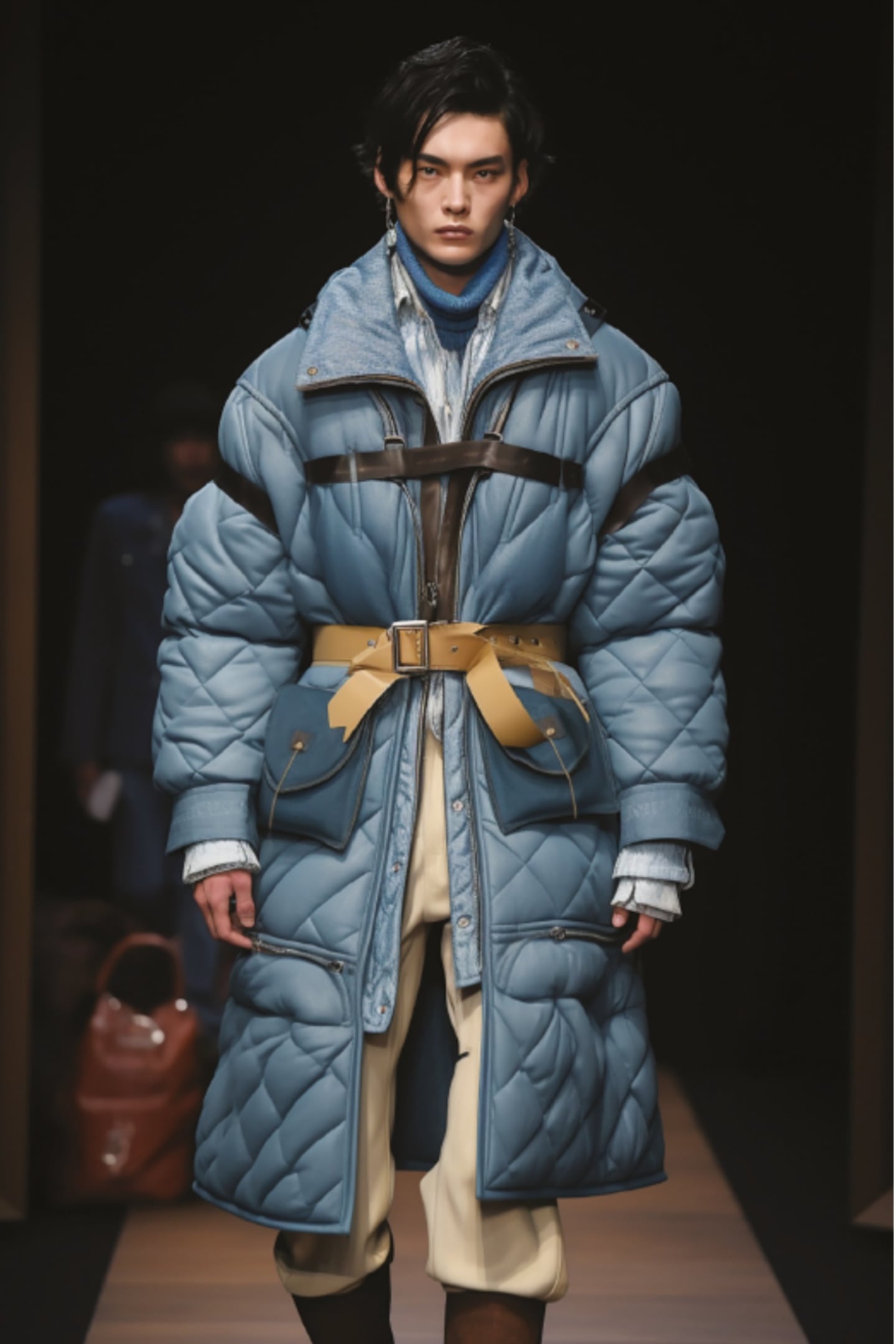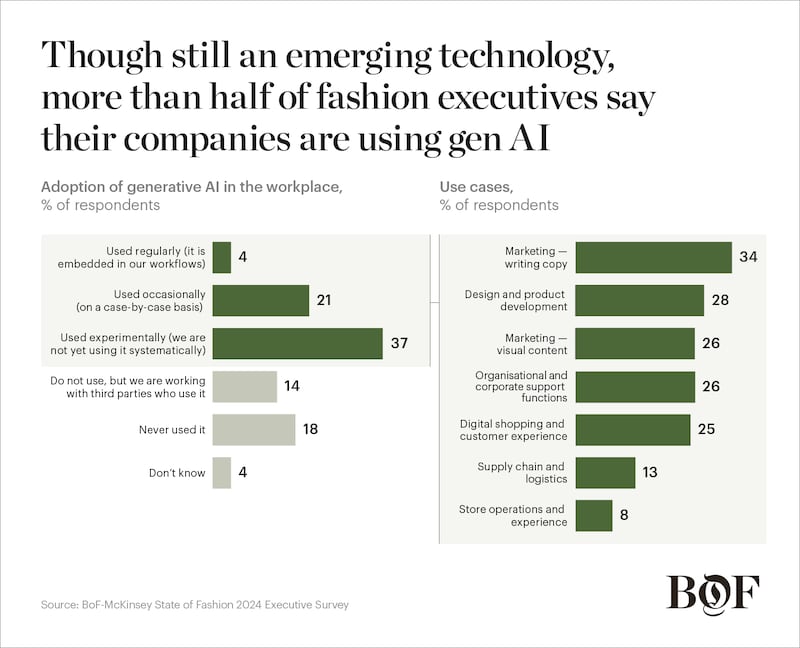
The Business of Fashion
Agenda-setting intelligence, analysis and advice for the global fashion community.

Agenda-setting intelligence, analysis and advice for the global fashion community.

 Opens in new window
Opens in new windowDisruptive technologies in the workplace generally fall into three categories — those that enhance existing skills while creating new ones; those that replace skills while reducing the need for others; and those that fall somewhere in between. So where does one of 2023′s buzziest technologies — generative artificial intelligence — fit? For creative teams in the fashion industry, the year ahead could help them find the answer.
Gen AI — algorithms pre-trained on large volumes of data such as text, images and code, often fine-tuned with other corporate data, that can create new, complex content — had a breakout year in 2023 as powerful new tools hit the market. By January, two months after its launch, ChatGPT reached an estimated 100 million users, a record pace of growth at the time. Multiple platforms and tools have since entered the market, and a dizzying array of start-ups are seeking to leverage these, while strong open-source alternatives are challenging proprietary models.
While the technology’s use is nascent in many industries, it’s accelerating. If its trajectory continues, it could be one of the most transformative technologies for the fashion industry in a long while. Early experiments have offered a promising start, but the transformative power of gen AI will become more evident as use cases move beyond one-off projects and become embedded within fashion’s value chain.
The overall financial impact of gen AI on the industry is potentially significant. According to recent McKinsey analysis, as much as one-fourth of the value is expected to be driven by use cases at the design and product development stage of the value chain.
ADVERTISEMENT
It’s no surprise then that gen AI is on industry executives’ radars. The BoF-McKinsey State of Fashion 2024 Survey of global fashion executives found 73 percent of respondents said gen AI will be an important priority for their businesses in 2024. Yet while many are experimenting with the technology, just 28 percent said their businesses had tried it for design and product, indicating fashion companies are not yet capturing its value in the creative process.
Caution is understandable. The technology could impact jobs and workflows. The fashion industry has also seen a fair share of technological enthusiasm that has swiftly sputtered — notably, the metaverse. Based on rate of progress and investment, however, gen AI is likely to offer a different story. The technology has more practical applications than the metaverse, making it more attractive to businesses and investors. Equity funding for gen AI-focused start-ups skyrocketed in 2023, reaching $14.1 billion in the first half of the year alone, compared with $3.5 billion in 2021 and $2.5 billion in 2022. A significant share of the surge was due to Microsoft’s January announcement of its $10 billion, multiyear deal with OpenAI, the research laboratory behind ChatGPT. In the second half of the year, Amazon announced a $4 billion investment in the artificial intelligence start-up Anthropic, pushing 2023′s investments in gen AI even higher.
Part of gen AI’s potential lies in the array of tasks to which it can be applied, and fashion businesses are already beginning to adopt it in several concrete ways. However, the focus so far has been on one-off use cases with clear advantages when it comes to cost, efficiency or customer experience, rather than those with potential for wider industry disruption.
Online shopping assistance is one area where it is making its mark. Online retailer Zalando announced the launch of a beta ChatGPT-based natural language-powered shopping assistant in spring 2023 that allows a visitor to its site to ask questions and get answers as well as customised product recommendations. Kering, Mercari and Shopify have similarly introduced AI chatbots.
Brands using the technology to write product descriptions for their sites include Snipes, a sneaker and streetwear retailer, and Adore Me, the lingerie company recently acquired by Victoria’s Secret. Shopify, meanwhile, has introduced a gen-AI writing assistant for merchants.
Other brands have begun exploring gen AI tools in one-off creative and marketing projects. Ganni used the technology at its Spring/Summer 2024 runway show for an installation that let guests ask questions and receive answers reflecting Ganni’s point of view. Luxury label Casablanca created a campaign for its Spring/Summer 2023 collection by partnering with an AI artist and using image generator Midjourney. Casablanca creative director Charaf Tajer said human talent and creativity were required to produce the richly hued, stylised campaign set against a desert landscape in Mexico. But he also acknowledged efficiency gains as a result of bypassing all the planning and costs of in-person photo shoots, among other benefits.

Specific gen AI deployments like Zalando’s and Casablanca’s have piqued the interest of both the wider industry and consumers. But the technology has not yet been systematically scaled beyond pilot projects. Ultimately, the greatest value may lie in using gen AI in an end-to-end way that enables and enhances creativity.
Use cases may differ across segments of the industry. In fast fashion, gen AI can accelerate the design process, injecting more agility from trend detection to product development and by leveraging analytics data to rapidly produce large numbers of new designs. Meanwhile in luxury, gen AI could become an additional medium in the designer’s repertoire, allowing them to experiment with rapid iterations, compile mood boards that draw from diverse sources and curate the output. It can equip less technically skilled designers with the ability to visualise their concepts. The unexpected results produced by AI tools can even provide inspiration.
ADVERTISEMENT
Fashion brands Collina Strada and Heliot Emil have leaned into this space to craft their Spring/Summer 2024 collections. Both fed images of previous looks into a gen-AI tool to produce new designs that could be refined with text prompts. Online retailer Revolve also used the technology for a series of eye-catching, colourful billboards and dropped a limited capsule collection with garments from the campaign, with further experiments under way. Meanwhile, Spanish brand Desigual launched an on-demand collection that was designed using AI tools.
Companies developing gen AI software for fashion say the technology can reduce manual tasks that take days to mere hours or even seconds. AiDA (short for AI-based Interactive Design Assistant) reportedly can produce a dozen fashion templates within 10 seconds. The system uploads sketches, materials and colour palettes to a virtual mood board with the help of a tagging tool for accelerated product searches. AiDA then creates templates that designers can finesse and augment. Cala, a fashion supply chain interface that includes gen AI in its design tools, can help designers produce more than 100 sketches in a single day, according to co-founder Andrew Wyatt.
In fashion, human skill and creativity often hold the key to brand differentiation. Rather than diminishing them, gen AI used properly can free designers from manual tasks to focus on creative work. Human designers will remain key, while gen AI will enable their roles to be orientated around curation. This potential must be communicated clearly to creatives to ensure the technology is adopted without undermining the role of the designer.
As the number of gen AI adopters in fashion expands and the technology evolves, it will require more than a superficial understanding of its role in enhancing and unlocking creativity. It holds exciting potential for companies to create unique gen AI models that enable them to infuse their brand DNA across design processes, rather than relying on the generic output of image generators. For creatives, success will hinge on the support and infrastructure of their ecosystems that enable them to move from manual creators to true creative curators. When implemented effectively, the technology can benefit and amplify the creative process, thus augmenting human capability, while retaining the artistic skills and knowledge of designers. Ultimately, say experts, human-centred innovation will likely be the most important use of AI.
This article first appeared in The State of Fashion 2024, an in-depth report on the global fashion industry, co-published by BoF and McKinsey & Company.
The eighth annual State of Fashion report by The Business of Fashion and McKinsey & Company reveals an industry navigating deep uncertainty. Download the full report to understand the 10 themes that will define the industry and the opportunities for growth in the year ahead.
The algorithms TikTok relies on for its operations are deemed core to ByteDance overall operations, which would make a sale of the app with algorithms highly unlikely.
The app, owned by TikTok parent company ByteDance, has been promising to help emerging US labels get started selling in China at the same time that TikTok stares down a ban by the US for its ties to China.
Zero10 offers digital solutions through AR mirrors, leveraged in-store and in window displays, to brands like Tommy Hilfiger and Coach. Co-founder and CEO George Yashin discusses the latest advancements in AR and how fashion companies can leverage the technology to boost consumer experiences via retail touchpoints and brand experiences.
Four years ago, when the Trump administration threatened to ban TikTok in the US, its Chinese parent company ByteDance Ltd. worked out a preliminary deal to sell the short video app’s business. Not this time.